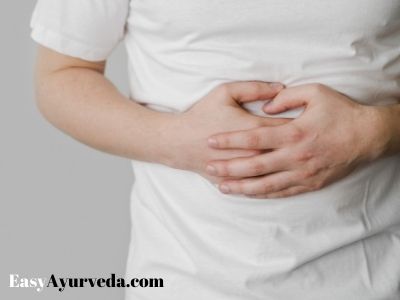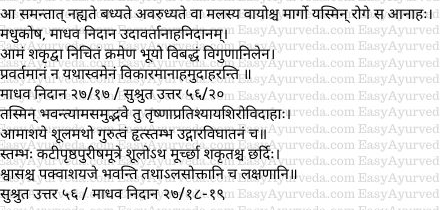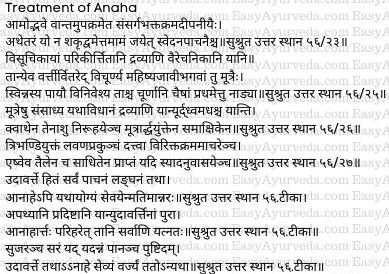Anaha Pathogenesis, Types, Symptoms, Treatment
By Dr Raghuram Y.S. MD (Ay) & Dr Manasa, B.A.M.S
Anaha means Constipation/Suppression of urine and faeces. When there is obstruction in the passages of feces and gases and when they are not excreted from both directions i.e. upward (mouth) or downward (anal) routes the condition will be called as anaha.
Read – Constipation Causes, Ayurvedic Treatment, Home Remedies

Table of Contents
Pathogenesis of Anaha
- Gradual accumulation and stagnation of ama i.e. undigested food in the stomach or feces and gases in the colon and
- Blockage in the channels of excretion of ama, feces and gases
- Further blockage of ama and feces in their respective seats by aggravated vata
- Non elimination of ama and faeces from their respective passages causing anaha
Read – Symptoms Of Vata Dosha Increase And Imbalance – Vata Vruddhi Lakshana
Types of Anaha
Since anaha is formed due to accumulation of ama or feces, anaha is also of 2 kinds depending on what has been obstructed.
Amaja anaha – anaha caused due to the accumulation and obstruction of ama in the stomach (the organ wherein ama is formed), it is also called as amashayaja / amashayagata anaha since the disease has its origin in the stomach (amashaya = stomach)
Purishaja Anaha – anaha caused due to accumulation and obstruction of feces in the intestines and colon, it is also called as pakvashayaja / pakvashayagata anaha since the disease has its origin in pakvashaya = large intestine / colon.
Accumulation of excreta occurs in both stomach and colon. The wastes formed and accumulated in the stomach is called as ama and those formed and accumulated in the intestines is called as purisha i.e. feces.
Read – Qualities And Symptoms Of Ama – Ama Guna Lakshana
Symptoms of Anaha
Generalized symptoms
- Mala marga avarodha – constipation
- Vayu marga avarodha – obstruction to elimination of gases in both upward direction (belching) and downward direction (fart)
Symptoms of amaja anaha
- Trishna – thirst
- Pratishyaya – rhinitis
- Shiro vidaha – headache / irritation in the head
- Shula – abdominal colic / pain in the upper part of the abdomen
- Gutvam – heaviness in the abdomen / body
- Hrt stambha – stiffness in the chest / cardiac region
- Udgara vighatanam – obstruction of belching
Read – Kukshi Shula Causes, Symptoms, Pathogenesis, Treatment
Symptoms of purishaja anaha
- Kati stambha – stiffness in the pelvis
- Prshta stambha – stiffness in the back
- Purisha stambha – constipation
- Mutra stambha – obstruction of urine / urinary retention
- Shula – abdominal pain
- Murcha – loss of consciousness
- Shakrtascha chardi – excretion of faeces from mouth / fecal vomiting
- Shvasa – breathlessness
- Alasaka lakshana – symptoms of alasaka disease
Read – How To Know That Your Digestion System Is Working Fine?


Treatment of Anaha
Treatment principles of amaja anaha – In the anaha caused by accumulation of ama in the stomach initially therapeutic emesis should be done. This would not only expel the doshas but also would cleanse the stomach of its impurities. Following this samsarjana krama i.e. graduated diet should be followed. The intention is to kindle the digestive fire which has reduced and become weak due to emesis therapy and also to restore strength and energy. This dietetic protocol consists of starting the food with easily digestible liquid foods. Gradually the food is graduated to semisolid foods and later to the normal foods.
The foods used in the graduated diet shall be processed and prepared with ‘digestive fire kindling herbs’ like Pippalyadi group of herbs etc. Drinking water is also processed with the same herbs. This shows that correction of digestive fire and bringing it to a state of balance is the prime strategy in the treatment of anaha but should be done on the backdrop of cleansing therapy, mainly emesis as already specified.
Read – Deepaneeya Gana Herbs Of Charaka: Review, Benefits, Formulations
Treatment principles of purishaja anaha – Digesting ama is a key strategy in treatment of this variant of anaha also. The purishaja anaha in which there is no emesis of feces (which is a serious complication of the disease and indicates its bad prognosis) alone should be treated. In the disease wherein there is emesis of feces should be rejected because it is incurable. In the ‘curable form’ of this disease management shall be done by administering sudation therapies and ama digesting measures and medicines.
Medicines used in Vishuchika
Vishuchika is another gut related condition which is often compared to cholera. The medicines and formulations used in the treatment of vishuchika are also used to treat anaha. The purgative herbs mentioned in vishuchika should be ground in the urines of buffalo, goat, sheep, elephant and cow (once with each urine), cooked and wicks are prepared. These suppositories should be introduced into the anus of the patient of anaha who has been subjected to sudation therapy in a proper way. Alternatively the powder of purgative herbs shall be blown into the anal canal using the tubular instruments.
Niruha Vasti – Anuvasana Vasti
Decoction and oil (ghee) enemas are very effective in treating anaha.
1. Niruha – Decoction Enema
For decoction enema the below mentioned ingredients are taken for preparing decoction –
Herbs used for administering emesis and errhines as mentioned in the Samshodhana and Samshamaniya chapters like Madanaphala (Randia dumetorum), Koshataki (Luffa acutangula) etc are taken.
Herbs used for administering purgation like Haritaki (Terminalia chebula), Aragwadha (Cassia fistula), roots of Ricinus communis, Trivrt (Operculina turpethum) etc are taken.
The above said medicines processed in the urines of cow, buffalo etc and decoction prepared as per the procedure. The filtered decoction is added with half the quantity of cow’s urine, 48 grams of honey, and the same quantity of powder of Operculina turpethum and Rock Salt and mixed thoroughly. The resultant medicine is administered as decoction enema.
Following this the samsarjana krama i.e. graduated dietetic regimen as explained in the context of therapeutic emesis and purgation is administered.
2. Anuvasana – oil enema
The decoction and paste of the same emetic and purgative herbs shall be used to prepare the oil needed for oil enemas in the treatment of anaha.
Diet in anaha
All the beneficial dietetic inclusions and lifestyle changes which are advised in the treatment of udavarta disease including measures like ama digesting medicines, fasting and other lightness producing treatments shall be included in the treatment of anaha as and when required.
Avoidable things in anaha
The same rule as above applies here. All things which are said to be avoided and contraindicated in udavarta disease shall also be avoided by the person suffering from anaha.
Apthya – Yogaratnakara
Constipating foods, incompatible diet, astringent & heavy to digest foods etc.
Other inclusions
Easily digestible foods and drinks which do not cause constipation can be included in diet for the treatment of anaha and udavarta. Included food should also be nutritious.
Read – Udavarta – Reverse Movement Of Vata Dosha Causing Disease
Modern correlation
Amajanya Anaha is manifested in the stomach. Therefore, the symptoms of this condition are limited to the stomach. This condition can be compared to ‘pyloric obstruction’ explained in modern texts. It is the obstruction due to narrowing or other causes of the lower end of the stomach wherein it opens into the small intestine.
Purishajanya Anaha is manifested in the intestine / colon. Therefore, the symptoms of this condition are limited to the colon. This condition can be compared to ‘intestinal obstruction’ explained in modern texts. Due to the intestinal obstruction, constipation will occur, the feces are not excreted and may also cause purisha udavarta i.e. upward movement of feces towards the mouth and thus fecal vomiting may occur as a complication.
Click to Consult Dr Raghuram Y.S. MD (Ayu)









